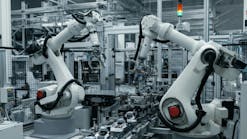Say “thank you” to a pneumatic actuator next time you enjoy a craft beer. Or eat a watermelon. Or open a can of paint. Or interact with any of a number of objects, from cars to pills, in your daily routine.
The workhorses behind the scenes of our modern lives are linear actuators that push, pull, rotate, clamp, move and position the products (or the machines that make the products) we use every day. This article discusses the different types of actuators, also called cylinders, and then highlights ways in which actuator features can be selected for maximum efficiency and performance in specific applications.
Types of Pneumatic Actuators
The most familiar industrial pneumatic actuator is a rod-style cylinder. A rod attached to a piston inside a barrel or tube extends through a sealed opening at one end. The load is connected to, or contacted by, the rod. Compressed air controlled by a valve enters the barrel and moves the piston, which moves the rod. A port at the other end allows the air to escape. The rods of single-acting actuators are moved by compressed air and go back to their starting position by means of a spring return. Double-acting actuators are moved by compressed air in both directions.
Another type of pneumatic actuator is the rodless cylinder. Instead of being moved by a rod, the load is moved by an external carriage along the tube’s surface. Rodless cylinders save space and can deliver longer strokes than rod-style cylinders because the stroke is contained within the overall envelope of the cylinder. Rodless cylinders also handle high moment—the forces acting above, below, or to one side of the center of the piston.
Match the Actuator to the Application
Selecting the right actuator for an application starts by answering a few simple questions:
- What is the desired end result of the operation?
- What work will the actuator perform—lift, push, open/close?
- How large or heavy is the load?
- How far must it move?
- How quickly must the cylinder strike and recover?
- How will the motion be stopped?
- What is the operating environment?








